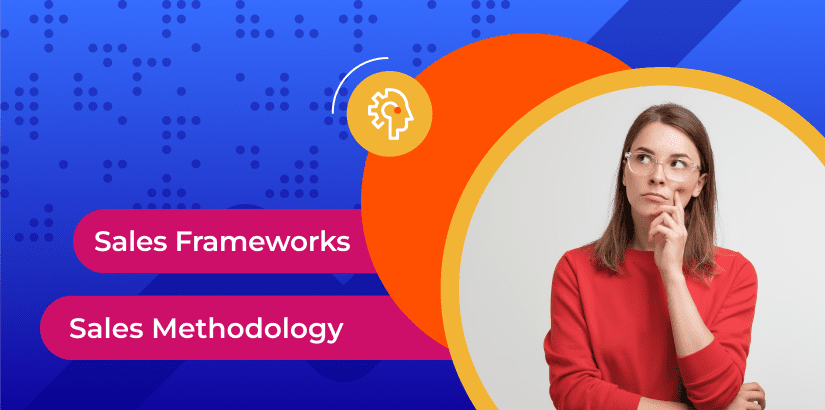If your teams don’t have a sales methodology, they need one — and fast.
You also aren’t alone.
According to our 2022-2023 Sales Enablement Outlook Report, less than half (43%) of respondents say their organizations have an institutionalized sales methodology.
The best sales methodologies act as a framework, guiding reps through each stage of the sales process. These approaches should be scalable, measurable and — perhaps most importantly — repeatable. But there are tons of common sales methodologies out there, and while each has its benefits, you need to know which fits your business best.
Here’s your guide to sales methodologies and how to make the right choice.
What is a sales methodology?
A sales methodology is like a thread uniting different stages of the sales cycle. When your reps follow this thread, they know exactly what to say and when to say it, what buyers are thinking at different times and how to build better relationships. While the customers, products and teams may change, the best sales methodologies can stay consistent because they’re based on best practices.
Of course, that’s not to say that a sales methodology is “one size fits all.” These frameworks can and should scale depending on new training materials, shifting buyer expectations and what you learn in the ever-changing world of sales.
Why is a sales methodology important for any business?
Sales reps might feel they have an instinct for making all the right moves in customer communication — and they could very well be right. The best sales methodologies don’t replace those instincts, but rather build on them to create a shared, consistent approach that keeps every individual and team pushing in the same direction.
Here are a few more reasons you need a sales methodology:
Solid sales frameworks are flexible enough to enable accurate, personalized responses without changing your approach for every individual buyer.
Toggle ContentThese guidelines are informed by sales performance metrics and best practices, which means they’re based on what actually works instead of what should work.
A single sales methodology unites many sales processes to encompass every activity, interaction and stage for both buyers and sales reps.
Skip the guesswork and let your sales frameworks identify where and when a lead fits into your pipeline.
With the right set of guidelines, your reps will be better prepared to overcome challenges, address hesitations and build trust — the first step toward more and better deals.
As your business and customers change, your sales methodology will too. You’ll have the insight, data and tools you need to identify what’s working, what isn’t and where improvements need to be made.
What are some common sales methodologies?
When choosing the best approaches for your teams, it’s often helpful to have sales methodology examples in front of you. Here are just a few to consider:
MEDICC
MEDDIC is an acronym that represents a comprehensive sales qualification framework. Each letter in stands for a key element in the sales process.
- Metrics refers to understanding the quantifiable goals and objectives of the customer.
- Economic buyer refers to identifying the person who has the authority and financial power to make purchasing decisions.
- Decision criteria involves understanding the specific requirements and criteria that the customer uses to evaluate potential solutions.
- Decision process refers to comprehending the steps and individuals involved in the customer’s decision-making process.
- Identify pain involves discovering and understanding the customer’s challenges, problems, and pain points.
- Champion refers to finding an internal advocate within the customer’s organization who supports and promotes your solution.
Takeaway: Use the MEDDIC framework to thoroughly understand customer needs, decision-making process, and leverage internal champions for successful sales.
BANT
BANT is a sales qualification methodology and assesses potential customers. It stands for Budget, Authority, Need, and Timeline. Each element represents a crucial aspect of determining the viability of a sales opportunity.
- Budget refers to understanding the prospect’s financial resources and whether they have the means to make a purchase.
- Authority involves identifying the decision-makers and influencers involved in the buying process.
- Need refers to assessing the prospect’s specific pain points and determining how well your product or service can address them.
- Timeline involves understanding the prospect’s urgency and when they intend to make a decision or implement a solution.
Takeaway: Assess leads effectively using BANT: Determine budget, authority, need, and timeline to prioritize sales efforts and qualify potential opportunities.
Consultative selling
The most important part of consultative selling is right in its name: the consultation. Buyers come to you because they have unanswered questions, and they need your reps to act as guides. Key processes involve listening, communicating and collaborating.
Takeaway: Consultative selling builds trust by being primarily informational instead of promotional.
Solution selling
Sometimes, customers already know exactly what their problem is — all you have to do is tell them what the solution can look like. Even before the first call, this sales methodology requires that your reps have a particularly solid understanding of:
- The buyer
- Their needs and challenges
- The most targeted offerings for their situation
Takeaway: Solution selling is more focused on addressing a problem than selling a particular product or service.
Provocative selling
When you use this framework, your reps need to be able to identify pain points before buyers do and then provoke them to research solutions. In many ways, reps are “selling” problems first and products second.
Takeaway: Provocative selling is all about being proactive and giving customers what they didn’t even know they needed.
Challenger sales
Matthew Dixon and Brent Adamson developed “The Challenger Sales Method.” In their book of the same name, they discuss various seller archetypes and identify the most successful: challengers, who represented 40% of high-performing sales reps in the authors’ study.
Takeaway: Challenger sales methodologies focus on empowering other rep archetypes to teach prospects, tailor their communications and take control of sales.
Inbound selling
In this sales methodology, you acknowledge that buyers are doing more work themselves and may not contact your reps until they’re well into the pipeline. That means sales might take a back seat for your reps as they educate and advise buyers.
Takeaway: With inbound selling, qualified leads come to you instead of the other way around — so while the sales processes might look different, they may be far more efficient.
SPIN selling
Neil Rackham’s book, “SPIN Selling,” builds a sales methodology around four key kinds of questions:
- Situation: What is the customer’s current need or challenge
- Problem: Where is the problem coming from?
- Implication: What happens if nothing is done?
- Need-payoff: What are the benefits of solving the problem?
Takeaway: When strung together, these kinds of questions allow reps to lead buyers on a kind of realization journey in which they connect their problems to specific solutions.
Target account selling
This sales methodology is all about research and automation. It’s an approach that emphasizes the importance of choosing the right accounts to focus on — those that will be most responsive and easiest to sell to.
Takeaway: Research is vital in all the best sales methodologies, but it’s at the heart of target account selling — so reps must fully understand personas, key decision-makers, in-depth challenge breakdowns and more.
Sandler Selling Method
This approach is built on the concept that buyers and sellers must trust one another to have a successful relationship. That means there has to be communication, collaboration and mutual respect. This methodology is similar to consultative selling but has a more prescriptive framework: building a relationship, quantifying the lead and ultimately closing the deal.
Takeaway: The Sandler Selling Method works best when buyers want and need to be able to lean on reps as decision-making partners, not just sales experts.
How to identify and choose the right sales methodology for your business
Say you have a Software as a Service (SaaS) company. You do some research and find common approaches — but the best sales methodology for SaaS organizations isn’t the same as the best sales methodology for manufacturers, retailers, food sellers or real estate agents.
So how do you choose the right one for you?
Most common sales methodologies, among organizations who have one

Source: 2022-2023 Sales Enablement Outlook Report.
#1: Evaluate your business goals and objectives
Whether you’re trying to improve sales performance, boost revenue, grow your business or hit some other goal, it’s important to keep the future in mind when deciding on a sales methodology. This helps align your sales team with your overall business objectives and makes sales activities that much more efficient.
#2: Analyze target market and customers
To find out what works best for your customers, you have to know who they are, how they think and what markets they spend time in. With this analysis at your fingertips, you can choose methodologies that will resonate with your audience instead of relying on an ill-fitting or “tone-deaf” approach.
#3: Consider business size and industry
Think about how many people and resources you can dedicate to a sales methodology. Is there too much to do, or do the tasks and approaches seem well-balanced? The size of your business will have a big influence on this, but so will your industry, which dictates much of what customers expect and how your sales processes need to work together.
#4: Experiment and evaluate
Remember that sales methodologies can be mixed, matched and combined to make them work for you. Keep track of relevant data to see whether a certain approach is working or if you need to weave in concepts, processes or theories from other frameworks.
How to get started with implementing a sales methodology for your business
Once you’ve chosen a sales methodology, it’s time to jump in. Here’s how to get started:
Evaluate current skills
It’s important to know what your reps bring to the table and what they’ll need to learn to adapt to a new sales methodology. This is also a chance to reflect on your sales training methodologies and fill in any gaps.
Create new training material
As you train reps on the new sales methodology, make sure to cover:
- Which of their former processes are sticking around
- Which processes will be updated
- Which processes will be completely changed
- What your overall philosophy is
- What your goals look like.
- The benefits of the new methodology
Remember to make this sales training material consistent and easily accessible — not just to the sales teams but to all departments,
Assess and provide feedback
Track your reps’ learning curves and provide support, feedback or coaching where they need it most. Remember to capture best practices and particularly helpful examples to build out your methodology going forward.
Putting your sales methodology to use
If you want to choose, implement, track and improve a sales methodology, you can’t afford to do it in disparate systems. That’s not just bad news for your business outcomes; it also creates frustration for sales reps, other teams and even customers.
Instead, unite your sales activity in a single revenue productivity platform.
Ready to see for yourself?
Mindtickle in action
From onboarding and training to data capture, performance reviews, and ongoing learning, Mindtickle is your best bet for getting more out of sales methodologies.
Request a DemoThis post was originally published in June 2023 and updated in December 2023.







